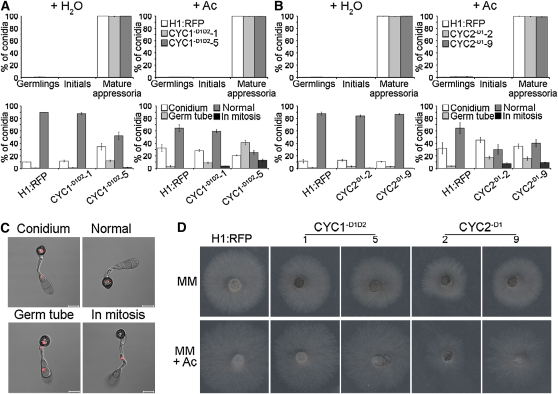Figure 4.
Expression of Stabilized Cyclin B Proteins in M. oryzae Inhibits Mitotic Exit but Does Not Prevent Appressorium Morphogenesis.
(A) Bar charts to show frequency of appressorium development (top panel) and nuclear distribution patterns (bottom panel) in two independent CYC1-D1D2 transformants (1 and 5). Appressorium development and nuclear distribution during appressorium morphogenesis were assessed in the presence or absence of 50 mM sodium acetate (Ac) 24 h postinoculation to induce expression of stabilized cyclins. For key, see legend to Figure 3.
(B) Bar charts to show frequency of appressorium development and nuclear distribution patterns in two CYC2-D1 transformants (2 and 9). Germinating conidia were incubated to allow appressorium development in the presence or absence of 50 mM Ac and observed 24 h later. All graphs represent two biological and three technical replicate observations of 100 germinating conidia. Error bars are 1 se.
(C) Representative images of CYC1-D1D2, CYC2-D1, and H1:RFP strains in the presence or absence of Ac during appressorium morphogenesis. Nuclei were scored as being both retained in the spore (Conidium), arrested in the germ tube (Germ tube), blocked in mitosis (in mitosis),or progressing normally through mitosis, resulting in a single nucleus in the appressorium and degradation of the remaining three nuclei (Normal).
(D) Phenotypic analysis of CYC1-D1D2 and CYC2-D1 expression on hyphal growth in M. oryzae. Plugs of mycelium (5 mm diameter) from ICL1(p):CYC1-D1D2, ICL1(p):CYC2-D1, and H1:RFP were incubated in the presence (MM + Ac) or absence (MM) of 50 mM Ac. Hyphal growth was assessed 4 d later. Bars = 10 μm.

